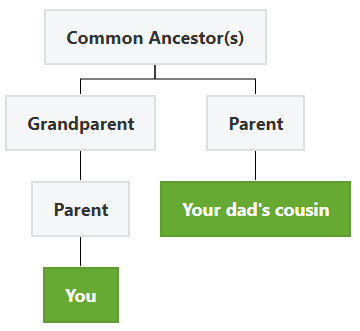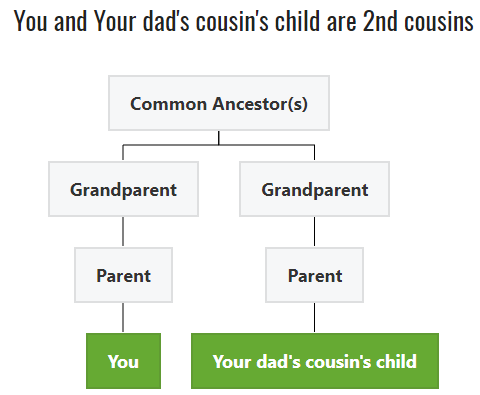If you’ve ever tried to figure out what your dad’s cousin is to you, this article will help. First of all, what kind of family relationship are we talking about? There are several types: first cousins, second cousins, third cousins, etc. Then there are cousins once removed, twice, etc. The difference between them is how many generations away they are from each other.
Your dad’s cousin is called your cousin once removed. That means they are one generation away from you.

If your father’s cousin had a child, that child would be your second cousin.

And if that child then had a kid, that child would be your second cousin once removed. You get the idea!
It can get confusing because sometimes people use the term “cousin” to mean any relative. So now you know what your dad’s cousin is to you!
Pro tip: Now that you understand cousins removed, why not explore your family’s unique story? Try MyHeritage’s 14-day free trial to delve into billions of records and uncover your family’s tale. What stories await in your family tree?
Calculating Cousin Relationships
Cousin relationships can be a little confusing, but by learning how to calculate cousinhood, you’ll be able to identify your cousins no matter where you are. Additionally, cousin charts can be limiting, so it’s important to know other ways to figure out relationships. That way, you’ll be able to understand your family history better.
Here are some basic steps to identifying a cousin relationship – without a chart!
For cousins that are in the same generation:
- Determine the most recent common ancestor between the two people whose relationship you are trying to determine. This may be a shared ancestor between you and a distant cousin, or perhaps between two other cousins.
- For great-grandparent relationships, you can simply “add 1” to the grandparent relationship, to determine the cousin relationship. For example, if you determine that both you and your mystery cousin share the same set of 2nd great-grandparents, that makes you 3rd cousins. If you share 4th great-grandparents, that means you are 5th cousins.
- If both of the cousins are in the same generation, then you will not need to calculate a “removed” relationship. Note that just because there’s a big age difference between you and your cousin does not mean you’re from a different generation.
For cousins that are NOT in the same generation:
- Follow the steps above for the person who is more closely related to the common ancestor. Let’s say only one of the cousins can trace these ancestors back as their 4th great-grandparents. You would assign this person a 5th cousin designation, as shown in the “add 1” example above.
- Next, determine the number of generations between the two potential cousins. Or conversely, determine how many generations further away from the common ancestor the second person is. If the second person is two generations further away from that shared ancestor (or, there are two generations separating the first and second person), then these two people would be 5th cousins twice removed.
What is my mom’s cousin to me?
Your mom’s cousin is also referred to as your first cousin once removed. This designation signifies that they belong to a generation one step away from yours. Just as with your dad’s side of the family, if your mom’s cousin had a son or daughter, these children would be your second cousins, putting them in the same generational bracket as you.


Is it ethical to use a DNA testing service like MyHeritage to uncover family secrets or potentially expose long-lost relatives without their consent during the free trial period?”,
“refusal
My mom and my dads cousin had children. Are my siblings also my second cousins?
Hi Tina. Are you saying your mom and your dad had the same cousin? Can you rephrase your question?